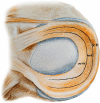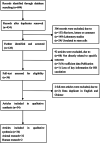In Vivo Studies of Mesenchymal Stem Cells in the Treatment of Meniscus Injury
- PMID: 34747566
- PMCID: PMC8654668
- DOI: 10.1111/os.13002
In Vivo Studies of Mesenchymal Stem Cells in the Treatment of Meniscus Injury
Abstract
This review summarizes the literature of preclinical studies and clinical trials on the use of mesenchymal stem cells (MSCs) to treat meniscus injury and promote its repair and regeneration and provide guidance for future clinical research. Due to the special anatomical features of the meniscus, conservative or surgical treatment can hardly achieve complete physiological and histological repair. As a new method, stem cells promote meniscus regeneration in preclinical research and human preliminary research. We expect that, in the near future, in vivo injection of stem cells to promote meniscus repair can be used as a new treatment model in clinical treatment. The treatment of animal meniscus injury, and the clinical trial of human meniscus injury has begun preliminary exploration. As for the animal experiments, most models of meniscus injury are too simple, which can hardly simulate the complexity of actual meniscal tears, and since the follow-up often lasts for only 4-12 weeks, long-term results could not be observed. Lastly, animal models failed to simulate the actual stress environment faced by the meniscus, so it needs to be further studied if regenerated meniscus has similar anti-stress or anti-twist features. Despite these limitations, repair of the meniscus by MSCs has great potential in clinics. MSCs can differentiate into fibrous chondrocytes, which can possibly repair the meniscus and provide a new strategy for repairing meniscus injury.
Keywords: Cytology treatment; MSCs; Meniscus injury.
© 2021 The Authors. Orthopaedic Surgery published by Chinese Orthopaedic Association and John Wiley & Sons Australia, Ltd.
Figures




Similar articles
-
Chondrogenically primed tonsil-derived mesenchymal stem cells encapsulated in riboflavin-induced photocrosslinking collagen-hyaluronic acid hydrogel for meniscus tissue repairs.Acta Biomater. 2017 Apr 15;53:318-328. doi: 10.1016/j.actbio.2017.01.081. Epub 2017 Feb 1. Acta Biomater. 2017. PMID: 28161573
-
Repetitive allogeneic intraarticular injections of synovial mesenchymal stem cells promote meniscus regeneration in a porcine massive meniscus defect model.Osteoarthritis Cartilage. 2014 Jul;22(7):941-50. doi: 10.1016/j.joca.2014.04.028. Epub 2014 May 2. Osteoarthritis Cartilage. 2014. PMID: 24795274
-
Additional Use of Synovial Mesenchymal Stem Cell Transplantation Following Surgical Repair of a Complex Degenerative Tear of the Medial Meniscus of the Knee: A Case Report.Cell Transplant. 2019 Nov;28(11):1445-1454. doi: 10.1177/0963689719863793. Epub 2019 Jul 17. Cell Transplant. 2019. PMID: 31313604 Free PMC article.
-
Preclinical Studies and Clinical Trials on Cell-Based Treatments for Meniscus Regeneration.Tissue Eng Part B Rev. 2023 Dec;29(6):634-670. doi: 10.1089/ten.TEB.2023.0050. Epub 2023 Jun 14. Tissue Eng Part B Rev. 2023. PMID: 37212339 Review.
-
[Homeostasis and Disorder of Musculoskeletal System.Transplantation of synovial mesenchymal stem cells for cartilage and meniscus regeneration.].Clin Calcium. 2018;28(3):319-327. Clin Calcium. 2018. PMID: 29512522 Review. Japanese.
Cited by
-
Cell-based therapy in the treatment of musculoskeletal diseases.Stem Cells Transl Med. 2024 Oct 10;13(10):959-978. doi: 10.1093/stcltm/szae049. Stem Cells Transl Med. 2024. PMID: 39226104 Free PMC article. Review.
-
Recent trends of stem cell therapies in the management of orthopedic surgical challenges.Int J Surg. 2024 Oct 1;110(10):6330-6344. doi: 10.1097/JS9.0000000000001524. Int J Surg. 2024. PMID: 38716973 Free PMC article. Review.
-
Meniscus Regeneration With Multipotent Stromal Cell Therapies.Front Bioeng Biotechnol. 2022 Feb 9;10:796408. doi: 10.3389/fbioe.2022.796408. eCollection 2022. Front Bioeng Biotechnol. 2022. PMID: 35237572 Free PMC article. Review.
-
Mesenchymal Stem Cells From Different Sources in Meniscus Repair and Regeneration.Front Bioeng Biotechnol. 2022 Apr 27;10:796367. doi: 10.3389/fbioe.2022.796367. eCollection 2022. Front Bioeng Biotechnol. 2022. PMID: 35573249 Free PMC article. Review.
References
-
- Clark CR, Ogden JA. Development of the menisci of the human knee joint. Morphological changes and their potential role in childhood meniscal injury. J Bone Joint Surg Am, 1983, 65: 538–547. - PubMed
-
- Fox AJ, Wanivenhaus F, Burge AJ, Warren RF, Rodeo SA. The human meniscus: a review of anatomy, function, injury, and advances in treatment. Clin Anat, 2015, 28: 269–287. - PubMed
Publication types
MeSH terms
LinkOut - more resources
Full Text Sources
Research Materials

